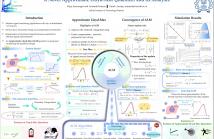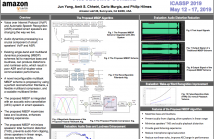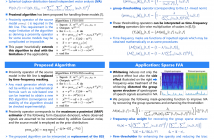
ICASSP is the world’s largest and most comprehensive technical conference focused on signal processing and its applications. The 2019 conference will feature world-class presentations by internationally renowned speakers, cutting-edge session topics and provide a fantastic opportunity to network with like-minded professionals from around the world. Visit website.

- Read more about PRACTICAL CONCENTRIC OPEN SPHERE CARDIOID MICROPHONE ARRAY DESIGN FOR HIGHER ORDER SOUND FIELD CAPTURE
- Log in to post comments
The problem of higher order sound field capture with spherical microphone arrays is considered. While A-format cardioid designs are commonplace for first order capture, interest remains in the increased spatial resolution delivered by higher order arrays. Spherical arrays typically use omnidirectional microphones mounted on a rigid baffle, from which higher order spatial components are estimated by accounting for radial mode strength.
- Categories:
 40 Views
40 Views
Several distributed real-time signal sensing/monitoring systems require quantization for efficient signal representation. These distributed sensors often have computational and energy limitations. Motivated by this concern, we propose a novel quantization scheme called Approximate Lloyd-Max (ALM) that is nearly-optimal. Assuming a continuous and finite support probability distribution of the source, we show that our ALM quantizer converges to the classical Lloyd-Max quantizer with increasing bitrate.
- Categories:
 149 Views
149 Views
Automatic speech recognition (ASR), audio quality, and loudness are key performance indicators (KPIs) in smart speakers. To improve all these KPIs, audio dynamics processing is a crucial component in related systems. Unfortunately, single-band and existing multiband dynamics processing (MBDP) schemes fail to maximize bass and loudness but even produce unwanted peaks, distortions, and nonlinear echo so that an optimized ASR performance cannot be achieved. It has been a goal in both industry and academia to find a better audio dynamics processing for mitigating these problems.
- Categories:
 81 Views
81 Views
- Read more about DEEP HIDDEN ANALYSIS: A STATISTICAL FRAMEWORK TO PRUNE FEATURE MAPS
- Log in to post comments
In this paper, we propose a statistical framework to prune feature maps in 1-D deep convolutional networks. SoundNet is a pre-trained deep convolutional network that accepts raw audio samples as input. The feature maps generated at various layers of SoundNet have redundancy, which can be identified by statistical analysis. These redundant feature maps can be pruned from the network with a very minor reduction in the capability of the network.
- Categories:
 21 Views
21 Views
- Read more about Poster for SUPER-RESOLUTION RESULTS FOR A 1D INVERSE SCATTERING PROBLEM
- Log in to post comments
In this work we consider the one-dimensional (1D) inverse scattering problem of super-resolving the location of discrete point scatters satisfying the 1D Helmholtz equation. This inverse problem has important applications in the detection of shunt faults in electrical transmission lines and leaks in water pipelines where usually only low frequency spectral information is available from measurements. We formulate the inverse scattering problem as a sparse reconstruction problem and apply convex optimization to super-resolve the location of point scatters.
- Categories:
 43 Views
43 Views
- Read more about Structural Recurrent Neural Network for Traffic Speed Prediction
- Log in to post comments
Deep neural networks have recently demonstrated the traffic prediction capability with the time series data obtained
by sensors mounted on road segments. However, capturing spatio-temporal features of the traffic data often requires a
significant number of parameters to train, increasing computational burden. In this work we demonstrate that embedding
- Categories:
 21 Views
21 Views
- Read more about Structural Recurrent Neural Network for Traffic Speed Prediction
- Log in to post comments
Deep neural networks have recently demonstrated the traffic prediction capability with the time series data obtained by sensors mounted on road segments. However, capturing spatio-temporal features of the traffic data often requires a significant number of parameters to train, increasing computational burden. In this work we demonstrate that embedding topological information of the road network improves the process of learning traffic features.
- Categories:
 35 Views
35 Views
- Read more about Time-frequency-masking-based determined BSS with application to Sparse IVA
- Log in to post comments
Most of the determined blind source separation (BSS) algorithms related to the independent component analysis (ICA) were derived from mathematical models of source signals. However, such derivation restricts the application of algorithms to explicitly definable source models, i.e., an implicit model associated with some signal-processing procedure cannot be utilized within such framework.
- Categories:
 135 Views
135 Views
- Read more about PHASE-AWARE HARMONIC/PERCUSSIVE SOURCE SEPARATION VIA CONVEX OPTIMIZATION
- Log in to post comments
In this paper, a phase-aware HPSS method through convex optimization was proposed. Based on two HPSS approaches (anisotropic smoothness and sinusoidal model), the proposed method assumes the smoothness of the complex-valued spectrogram of harmonic components calculated by iPC-STFT in the time direction. On the other hand, the time-frame-wise sparsity of percussive spectrograms was considered as a phase insensitive prior. Furthermore, the proposed method considers the perfect reconstruction constraint in the time domain instead of power spectrograms.
- Categories:
 85 Views
85 Views
- Read more about LOW-RANKNESS OF COMPLEX-VALUED SPECTROGRAM AND ITS APPLICATION TO PHASE-AWARE AUDIO PROCESSING
- Log in to post comments
Low-rankness of amplitude spectrograms has been effectively utilized in audio signal processing methods including non-negative matrix factorization. However, such methods have a fundamental limitation owing to their amplitude-only treatment where the phase of the observed signal is utilized for resynthesizing the estimated signal. In order to address this limitation, we directly treat a complex-valued spectrogram and show a complex-valued spectrogram of a sum of sinusoids can be approximately low-rank by modifying its phase.
- Categories:
 93 Views
93 Views